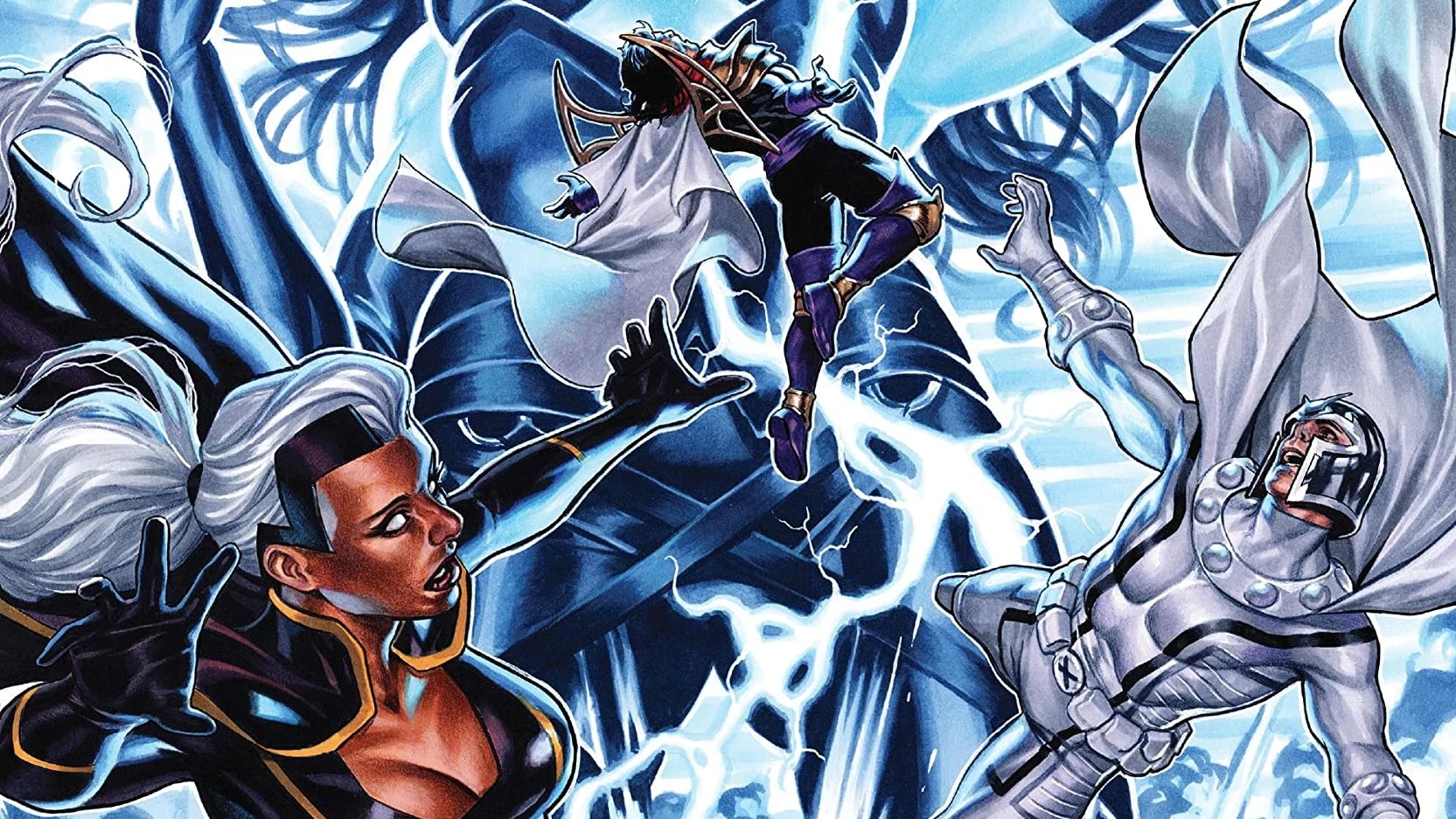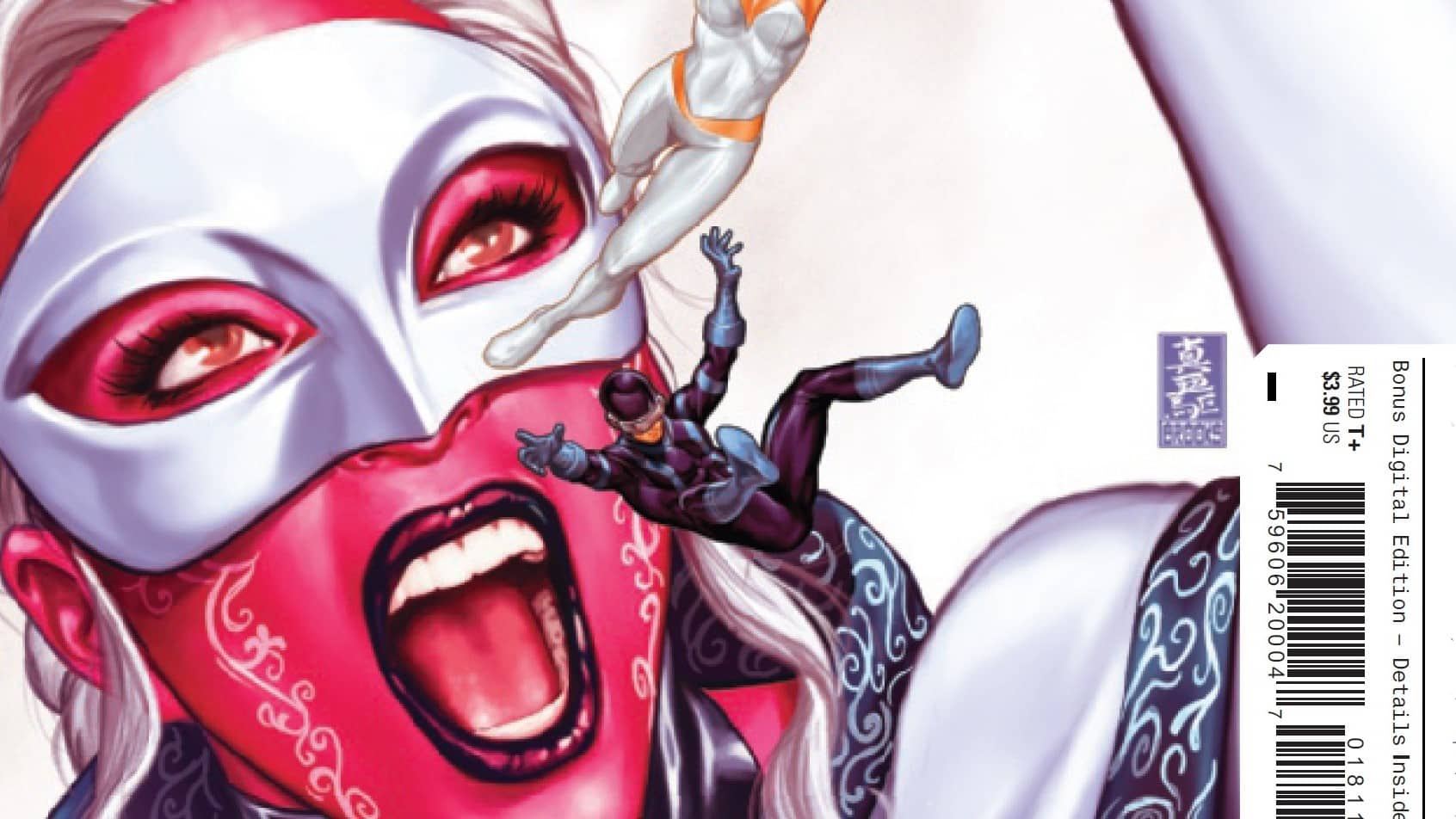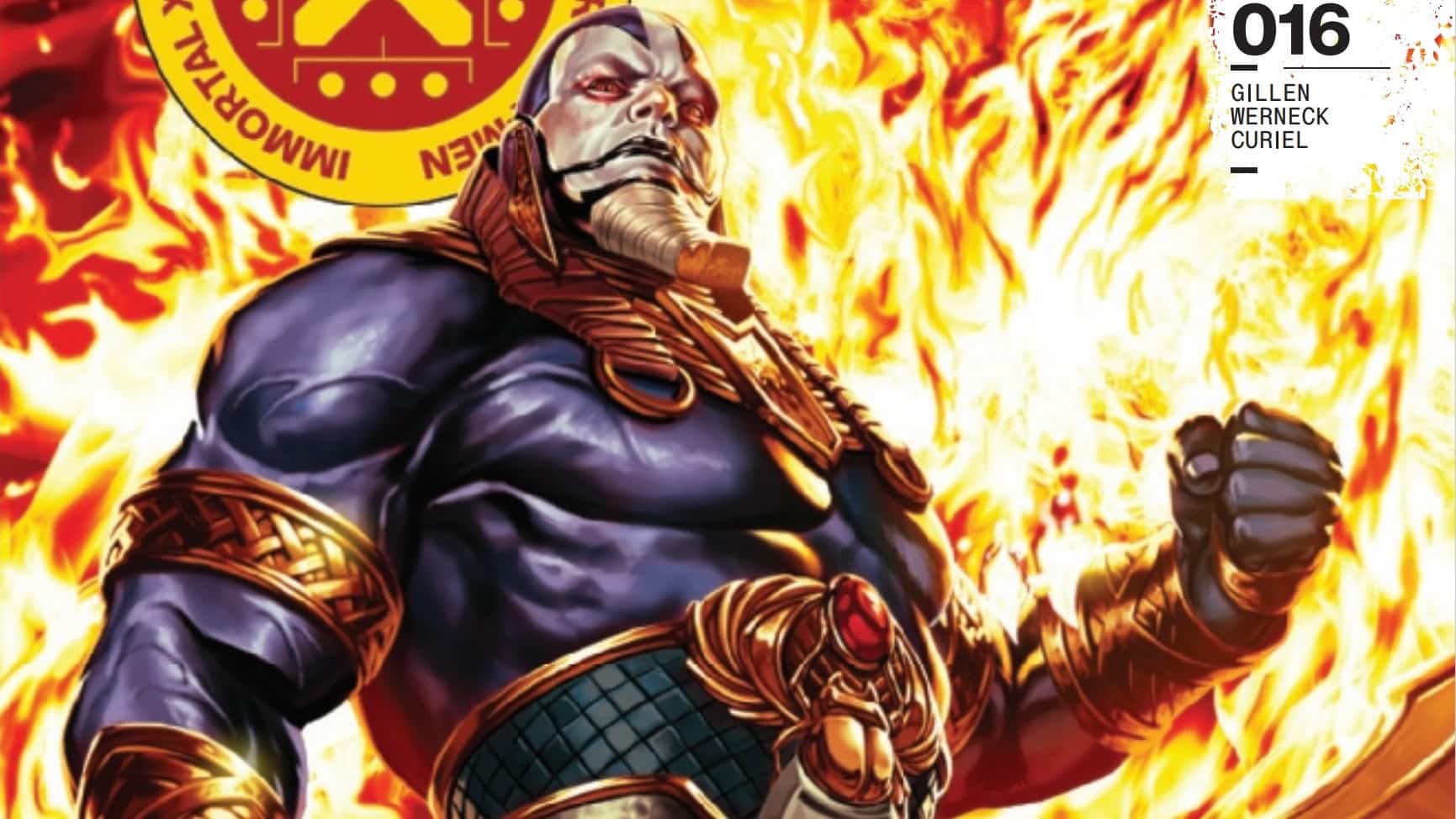In Immortal X-Men #2, our courageous council fights off a detestable Kaiju, and the new girl eliminates the threat with extreme prejudice. Written by Kieron Gillen, with line art by Lucas Werneck, colors by David Curiel and letters by Clayton Cowles.
Mark Turetsky: It’s been a month and a half since the premiere issue of this series, but mere seconds have passed in-world. Austin, my esteemed colleague, shall we ToX the ToX?
Austin Gorton: I’m pretty sure there’s a Summers Protocol that insists we do!
Lasciate Ogni Speranza

Austin: It feels like both only yesterday and ages ago (like so much else, blame supply chain disruptions) that the series launched with its complex examination of Mister Sinister. And while Sinister remains a fixture in this issue, as promised, writer Kieron Gillen shifts the focus to a new character with the new issue. Here, he puts us inside the head of everyone’s favorite maybe-messiah and militant adopted daughter of Cable, Hope Summers. Hope is an intriguing character in that she’s been important at various points in the X-narrative, but rarely is she allowed to exist at the center of her own narrative. What did you make of this peek inside Hope’s head?
Mark: Hope isn’t a character I’m intimately familiar with. The way she’s been treated in the Krakoan era has very much been an embrace, among other Krakoans, of her as a messianic figure. She’s one of the Five. She’s there when every mutant is brought back to life. She’s revered. Here, we see someone who’s internally in conflict with that identity, and by the end of the issue, you see what she’s capable of in a less-than-touchy-feely capacity. It’s a bit of a jolt, for me at least.
Austin: Gillen does a decent job here balancing what we do know of Hope – her role as Cable’s daughter, her upbringing as a soldier, her position as one of the Five specifically and a figure of mutant reverence more generally – while pushing her forward a bit and making her an active participant in the action. Her ultimate solution to the problem of the issue – killing Selene and then reviving her in order to take control of her mind in her weakened post-resurrection state in order to shut down her attack – combines both the violent pragmatism imparted to her by Cable and the kind of back alley dealing that has come to be the way the council gets things done more often than not of late.
Mark: Before we jump to her solution, let’s talk about the action of this issue: the External gate, having been transformed into a Kaiju, is threatening the Island. While issue #1 was very talky, in the way you’d expect from a comic about a ruling government body, this one is almost all action. In fact, most of the talky debate and council stuff is done away with in a data page.
First, I want to call out some really dynamic art by Wernick here. Look at the page where Exodus flies in from the background to meet up with Hope. It’s a five tier page, with each tier holding a single wide panel. The first three are really cinematic, essentially one continuous tracking shot of Hope helping other Krakoans, approaching the “camera” while Exodus does the same from the extreme background, before switching to a reverse shot for the fourth panel. It’s beautifully done, and a kinetic way of showing the chaos going on all around them. Also, Curiel’s colors do a ton in order to make it clear, separating out foreground, background and middleground elements in what could otherwise be a confusing page.
Austin: Werneck does some quieter stuff with body language that’s really fun as well. Take for example the panel of the “spring” side of the council reacting to the news of Hope’s solution: Kate is sitting forward, hands crossed, clearly engaged. On the other side is Shaw, lounging, sipping a martini, completely unengaged. In the middle of them is Emma, more focused than Shaw, less concerned than Kate. It’s an effective depiction of each of their personalities and their relationship as a voting bloc, all expressed without a single line of dialogue or narrative caption.
Mark: There’s also the lovely mutant-powered recreation of Michelangelo’s Creation of Adam, continuing the theme established by Mark Brooks’ classical religious artwork homages from his Trial of Magneto and Immortal X-Men #1 covers. Hope is on the left in the place of Adam, with Exodus on the right, in God’s place. On the one hand, it makes sense that Exodus is in the place of Michelangelo’s God, because he’s the one imparting the power. On the other, I would submit that Exodus would probably think he’s on the wrong side.
I also really like the double act that the two have in this issue. They work together, Hope humors him, but, as she puts it, she thinks he’s “%$#@&$# nuts” (also, that should be a clue to certain comics news outlets not to take everything he says at face value *cough cough*) [Ed. note: lalalala I can’t hear you over the sounds of mutant Jesus]. Her being able to use his abilities while thinking that about him points to her grimdark future survival skills. She’ll go along with what he says only insofar as it can help her get the job done. You also see it in her calculating deflection of Xavier’s question in front of the rest of the council, and her subsequent “Nailed it.” She knows how she’s seen, and she knows how to perform it. She’s a guileful politician, and already proving herself to deserve her spot.
Austin: And, again, to Gillen’s credit, this role for Hope and her skill in it is both surprising and consistent with her previous characterization.
The Thing With Feathers

Austin: While Sinister isn’t the spotlight character in this issue, he remains an active participant in the narrative. At one point, he injects himself with a new chimera prototype that theoretically makes him not unlike Hope (in that he manifests the powers and abilities of others) but in practice turns him into a big monster with Wolverine claws and weird spikes. “Chimera” is, of course, a loaded term post-HoXPoX and Hellions, and I was a bit surprised at how casually Sinister fessed up to what he was doing here.
Mark: His mutant monster look gave some Weapon H vibes (yes, I’ve read Weapon H, but not “Messiah Complex”). Also Hulklike is the fact that Sinister’s pants just get a bit torn up, despite his body blowing up to more than ten stories tall. I think his casual revelation of his work on chimeras is meant to head off criticism here, by showing off a less-than-successful implementation: it’s unstable! it only lasts a few minutes! also it saved the day! I’m glad to see that, even without the focus on Sinister in the issue, the narrative throughline of this story arc seems to be the century-long story between him, Destiny and Mystique (you know, the Immortal ones!).
Austin: I got Weapon H vibes off Chimera Sinister as well (*sigh* I read it too…). [Ed. note: I too read Weapon H and it’s good in spite of itself] And nice catch on the “immortal” bit. Given the way that struggle is being centered in the narrative, it’s interesting how Sinister is actively presenting himself as a hero here. Using the chimera formula, transforming into a kaiju-fighting muscle man, underlining his commitment to Krakoa: we know it’s an act, but the fact that he feels compelled to perform it at all is notable. Given how traditionally villainous Mystique is and how Destiny serves as an arbiter of fate, does Sinister see himself as the hero of their struggle?
Mark: He definitely sees himself as the protagonist, if not the hero per se. He’s save scumming his way through life, which is not something you do unless you consider yourself the PC (ugh, I feel dirty just alluding in the direction of the CHUDs who refer to other human beings as NPCs). And Destiny’s role in the issue is also interesting. She’s the one who gives Hope the intel to take out Selene. For all of Xavier’s bluster and attempts to control the situation, his way of doing things, debating policy in a forum, proves ultimately useless. It’s a backroom extrajudicial killing that gets things sorted in the end (with Shaw even expressing relief that they didn’t have to have a trial, yikes).
Austin: The bit with Hope and Destiny really caught my eye: precognition in a world with time travelers (and alternate realities) is always a bit dodgy, but Destiny’s visions of the future have almost always been observed and relayed by her from a relatively passive perspective. That is, aside from a few examples, the events she’s seeing either are or are not going to happen independent of her own actions. They can change, but Destiny usually isn’t the agent of that change.
Yet here, the act of her relaying her precognitive vision to Hope is the direct impetus for it coming to pass, and not even in a roundabout way. She tells Hope what to do, Hope leaves immediately to do it, then it’s done. Destiny didn’t just see this future: she made it happen. I’m curious if this is meant to be indicative of the more direct role Destiny has taken in the overall narrative post-resurrection (and a statement on the fact that she is no longer as passive a purveyor of prognostication as she once was), or simply a more immediate means to a particular plot end for Gillen.
Mark: And the means of assassination itself: it’s spectacularly flashy. It’s the opening moments of Morrison and Quitely’s Pax Americana, but thinking with portals. And the only mutant power she used was Magik’s teleportation. The midair sniper rifle headshot was just growing up with Cable. And here’s the thing: I’m not going to question that she had access to the rifle and to the mysterium bullet. If she has those easily at hand, she’s prepared for just about anything, isn’t she? And “anything” in this case includes killing fellow mutants. It’s like how Batman has files on how to kill all the other members of the Justice League, just in case.
Hope Slays X-Ternal

Mark: It’s interesting who Selene chose to side with here: it’s Coven Akkaba, last seen in Excalibur, turning the British against Captain Britain. It’s an odd choice for an alliance, especially since they’re anti-mutant, and specifically anti-Apocalypse, whom Selene evoked back in issue #1 as the presence that needs replacing on the council.
Austin: There’s also the whole External angle, in that in addition to being mutants both Selene and Apocalypse are super special immortal mutants, and yet, here she is, siding with a group that has a particular beef not only with mutants, but with one of the more prominent members of the group-within-a-group to which Selene specifically belongs. That said, the alliance with the coven does two things: on a more metatextual level, it helps continue making the Krakoan status quo feel big and lived in: with Knights of X having moved on from some of the Excalibur plot points, this is a way to keep one of that series’ antagonists on the board/in readers’ minds. It also helps underscore Selene’s more immediate point (and her ostensible motivation for wanting to be on the council and then throwing a temper tantrum in the form a giant slug kaiju formed out of External Gate): the council (and Krakoa) remains vulnerable to magic.
Mark: Absolutely true, and not all magical problems can be solved with an accurately projected antimagic bullet (also, that mysterium stuff is expensive, Coven Akkaba better harvest that and buy their own island with the proceeds!). And it looks like this will be an ongoing concern of the comic, with even the suggestion that Magik might be a good fit for the council. Still, if there’s one thing that this issue shows, it’s that the mutants on the council are a real force to be reckoned with by themselves. We complain about how much power the US senate might wield, but Joe Manchin can’t turn ambient energy into concussive blasts.
And I think it’ll be an ongoing concern with Destiny: her disorientation at the beginning of the issue was related to Storm and Magneto’s disruption of the gate, but that was all set to rights before she had her “you’re a ghost” attack at the end of the issue. Could we be seeing something related to Sinister’s Moira clone shenanigans interacting with the gate disruption? Could it be super science and mutant magic clashing in unforeseen ways? Maybe we’re looking at things in the wrong direction: instead of thinking the 1919 stuff is influencing the present, what if the present is influencing the 1919 stuff, what with how Destiny’s power works? Is her “we must be on the same side” something that’s happened already, something that has yet to happen, or something that happened in a previous Moira life?
Austin: To your point, it’s been all of two issues and we’ve already gotten two different means of “altering” reality: the Moira clones in issue #1, and the animated External Gate here (which threatens multiple dimensions when it’s injured due to it being constructed from, you know, a multidimensional portal). Both have an impact on Destiny’s powers and well being, but like you said, that also seems separate from whatever is afflicting her at the end. But between the two, both science and magic are represented, meaning that, while Selene isn’t wrong, the threat of magic isn’t the only one Krakoa is facing. .
X-Traneous Thoughts

- It’s noted that Hope’s power lets her be as good at using the power as the person she’s copying it from.
- She also gains an intrinsic understanding of how the borrowed power works, even beyond what the lender may know: she tells Exodus his power increases the more people believe in him (which connects his whole “zealot acolyte” personality trait directly into his abilities), something he didn’t know.
- Synch’s appearance in one panel in this issue seems out of place, somehow. He’s not in NY with the rest of his X-Men team, and none of them appear on Krakoa with him in this issue.
- Cyclops throwing shade via footnotes just cements my love for him.
- “You’re a ghost” is the refrain of the song “Paris 1919” by John Cale, found on the Immortal X-Men #1 playlist.
- Do we need to be worried about Hope? Exodus keeps making Jesus allusions in regards to her and Jesus’ time on Earth didn’t end, uh, well for him.






